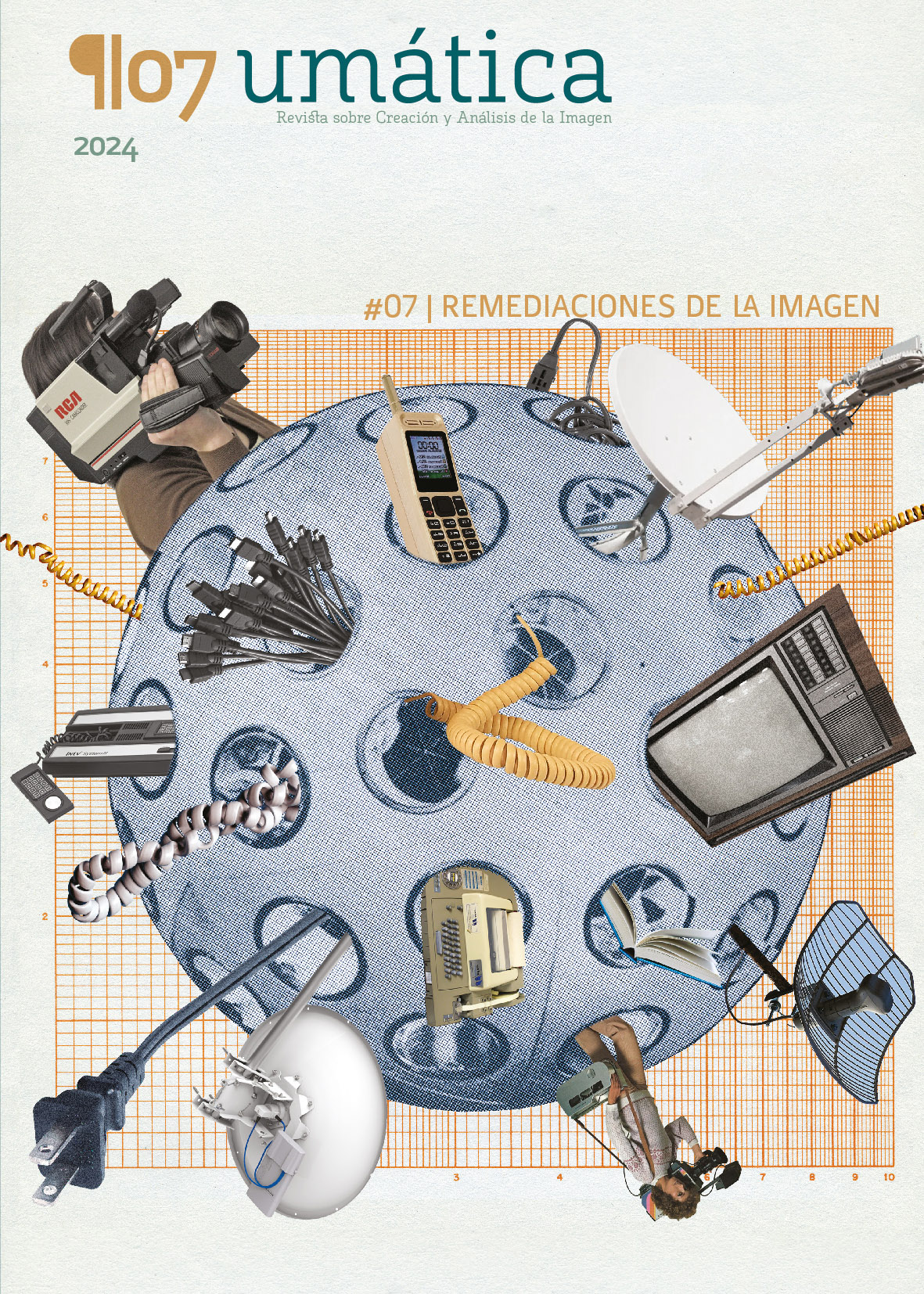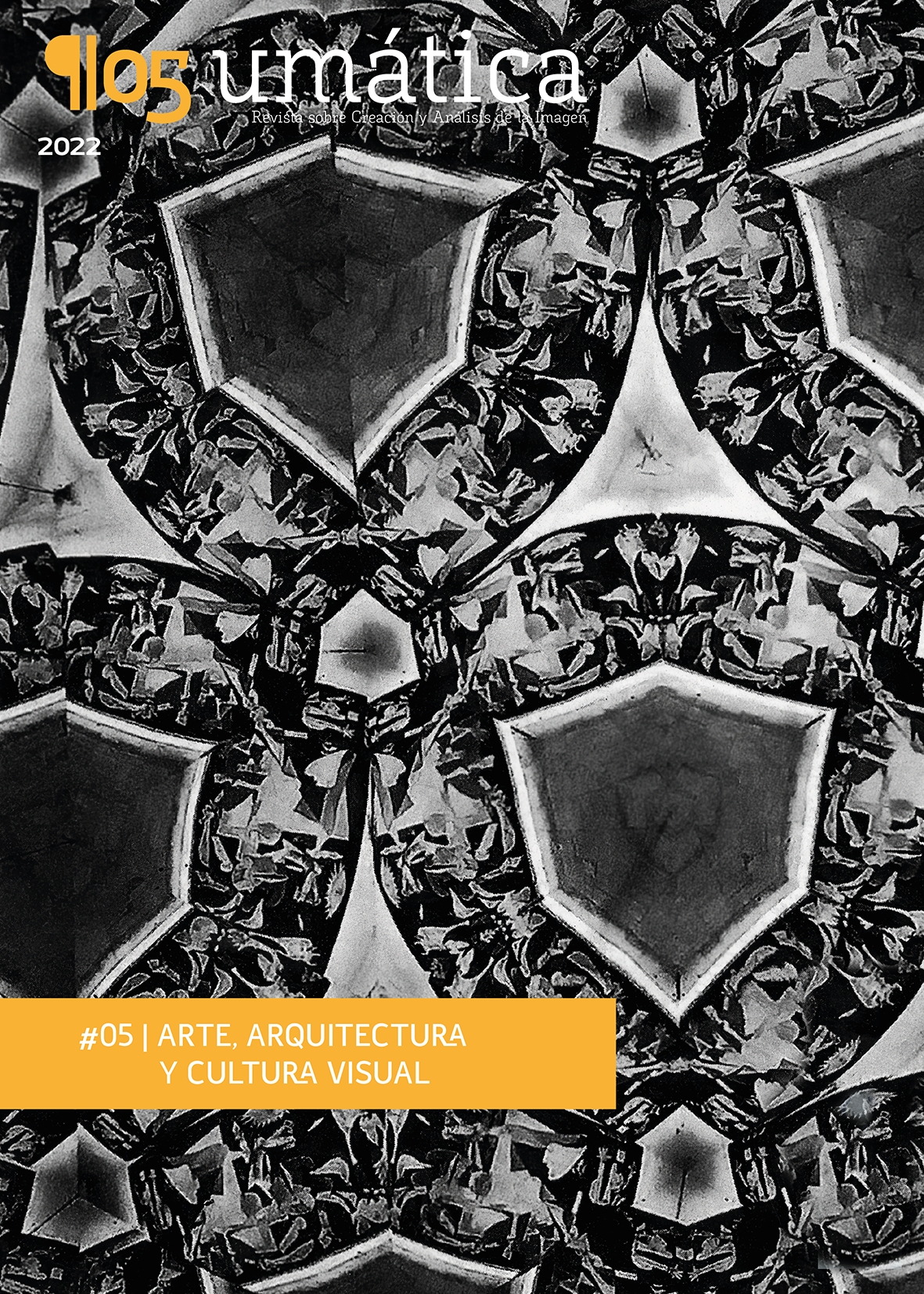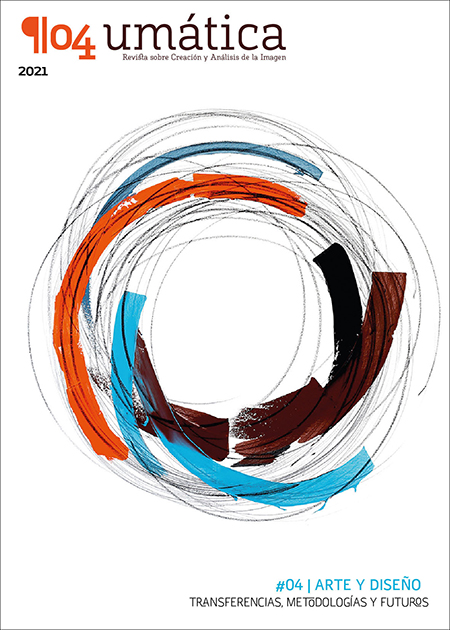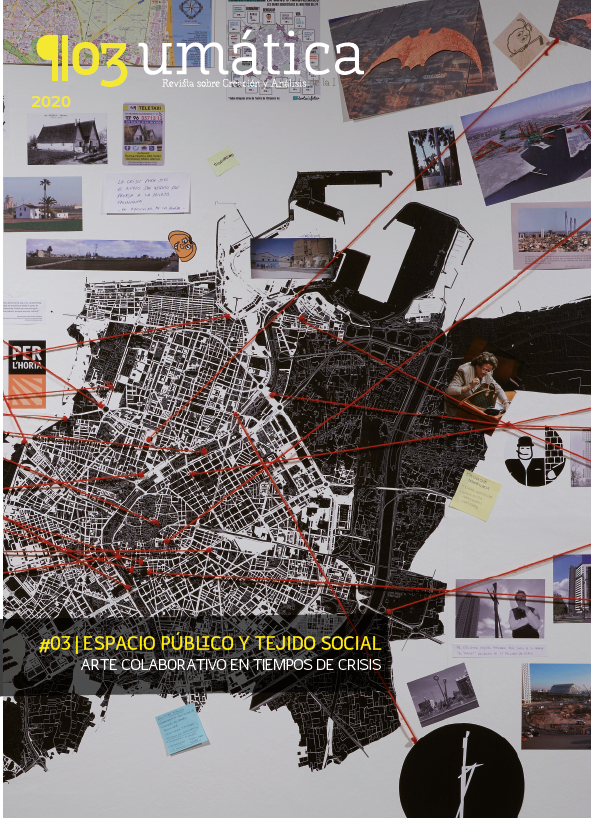Archives
-

Remediations of the Image: Audiovisualizations and (Dis)Appropriations of the History of Art and the Visual Culture
No. 7 (2024)The appearance of the television series Ways of Seeing in 1972, and the subsequent book of the same name, represented a radical intervention in the canonical narratives of art history that quickly became a project as admired as it was criticized. More than fifty years later, Ways of Seeing continues to arouse interest for the irreverent strategies it implemented: image remediation and montage, collaborative writing, modes of (dis)appropriation, and other non-linear ways of narrating art history from critically situated experiences.
Although these characteristics positioned Ways of Seeing as a crucial reference in the English-speaking world, in the Spanish-speaking context this influence does not seem to have had the same extent. In order to contribute to the debate on the relevance and validity of Ways of Seeing, the seventh issue of Umática integrates a set of reflections on different remediations of images, especially from Latin America and Spain. These are investigations based on exercises and experiments that dodge the conceptual and institutional architecture of authorship, ownership, genius and the male gaze, among other characteristics of the canon of Western art history.
In order to approach the remediation of images from this particular perspective, we have situated the debate around two fundamental notions: the audiovisualization of art history and the (dis)appropriation of visual culture. As complementary processes, these notions operate transversally throughout the different discussions of this monograph. Following Ways of Seeing, this issue brings together works that go beyond disciplinary boundaries and admit approaches such as the political philosophy of the image, feminist positions, reflections on audiovisual ecologies, reconceptualization of archives, critical pedagogy initiatives and other theoretical and methodological perspectives that, from their hybridity, venture into the various experiments opened up by the processes of audiovisualization of art history and (dis)appropriation of visual culture. This is neither a tribute nor an exhaustive review of Ways of Seeing, but rather the exploration of its possible remediations, contradictions and readjustments, more than fifty years after its appearance and in latitudes that surpass its frame of origin.
________________________
Editors:
Marilyn Payrol Morán (Benemérita Universidad Autónoma de Puebla)Alma Cardoso Martínez (Universidad Iberoamericana Puebla)
Renato Bermúdez Dini (Universidad Iberoamericana Ciudad de México)
________________________
Cover image: TRES (ilana boltvinik + rodrigo viñas), Starlette incrustado en órbita, 2024, collage.
________________________
With the support of:
Research group Tensiones superficiales. Estudios críticos de la imagen y la representación, Universidad Iberoamericana Ciudad de México.Research project MCIN/AEI PÚBLICOS - Los públicos del arte y la cultura visual contemporáneas en España Nuevas formas de experiencia artística colectiva desde los años sesenta (Ref. PID2019-105800G) and research group Devisiones. Discursos, genealogías y prácticas en la creación visual contemporánea, Universidad Autónoma de Madrid
-

AI-driven art: Artificial intelligence in art and design
No. 6 (2023)Exploring the intersection of art and AI: a reflective approach
The sixth edition of Umática presents a thought-provoking examination of the intersection between art and artificial intelligence (AI), drawing on Joanna Zylinska's influential work, "AI Art, Machine Visions and Warped Dreams" (2020). This exploration invites us to contemplate the mutually enriching relationship between humans and technology in the realm of creativity. The issue encompasses diverse perspectives on the challenges and opportunities presented by digital systems in artistic creation, from AI-generated digital media to the ethical considerations in image generation through prompts, as discussed by Professor Juan Martín Prada in "parasitic creativity." In this edition, readers are treated to exclusive interviews with both authors, offering deep insights into their views and contributions to the discourse on art and AI.
The journal also delves into the philosophical implications of the prevalence of simulacra in the AI era, raising questions about the nature of reality and truth in a networked world. This issue underscores the importance of addressing the evolution of authorship, originality, and ethics in art, as well as the need for training in new generative models and critically examining AI's role in contemporary art. Access to AI education, transparency, and equal opportunities are essential to bridge disparities and counter misinformation.
The utilization of AI digital media facilitates the investigation of Collective Visual Memory and Historical Re-collaboration. Through this medium, we can contemplate the influence of AI on our comprehension of the past and propose novel methods of remembrance through AI-generated images, while simultaneously grappling with the potential for falsehoods or remixes within historical narratives. The democratization of AI expands the realm of creative possibilities, yet simultaneously presents ethical dilemmas in integrating various styles and elements within generative systems. This issue brings to light several challenges that must be addressed in the years ahead, bearing in mind the rapid pace of technological advancements in the digital realm.
Cover image:
ZYLINSKA, J. (2023) -Still from A Gift of the World (Oedipus on the Jetty), [Photofilm, 9’25’’, 2021]. |© Zylinska, 2023 (Courtesy of the Author)[1]
--------------------
[1] A still from the project of the same name, in which Zylinska revisits Chris Marker's famous apocalyptic photographic film La Jetée (1962), training a StyleGAN2 model with stills from Marker's original, while writing a script with the help of an AI linguistic model.
-

Art, Architecture and Visual Culture
No. 5 (2022)Thinking about the city brings together different spheres of knowledge that open up a range of approaches to understanding it; a place overflowing with experience, an expanding territory currently marked by the phenomenon of globalization and the acceleration of experience in all its dimensions. In this sense, we have not been able to avoid reflections from art theory, as well as certain philosophical, sociological, psychological, scientific, historical, anthropological, and, in short, vital considerations, as these are an integral part of the passion that drives a visual culture that seeks to make visible the devices and rhetorics of legitimization that act on the city as formalized codes, and consequently on the modes of social relations.
This issue of Umática. Art, Architecture and Visual Culture has attempted to bring together contemporary visions as an act of cultural resistance. The interaction between disciplines today unfolds an open space and we have paid attention to some architectural developments and artistic practices in which we find vectors of meaning to investigate the fissures that we detect between the function and use of architecture and urbanism, between the memory and the present of the architectural fact as the significant cultural artifact that it is. The analysis of the surrounding reality and its causes, and the continuous reflection on everyday experience - from an artistic perspective that practices more the gaze of the active/critical passer-by than that of the tourist consumer/user - gives shape to this collection; projects that interrogate, question, define, underline, predict or alert us, if not directly in a tangential way, to the right to the city that Henry Lefebvre theorized. (...)
Cover image: Luis Camnitzer, The Perfect Crime (2018) | © Luis Camnitzer, 2018 (Courtesy of the Author).
-

Art and design: transfers, methodologies and Futures
No. 4 (2021)In today's world of transversal space where culture exerts a tension on the different fields of knowledge, an expanded perspective that allows interaction between disciplines, as offered by design processes, is more necessary than ever. 'Design' provides a field of exploration where experimentation, creation and the tangible are connected, in a present that predicts the future. This Umática monograph approaches those other presents.
There are traditional points in the design field displaced at the core of debates, such as the dogma of the search for solutions (new solutions to old problems), when the actual need to ask further questions emerges. Everything is questioned because everything is re-designed, re-measure, re-cycled, re-made, re-taken, 'RE-'... From the vision of the ordinary, the most human, the social, etc., without eminent corporate ambitions, the design responds to what we will have to live and how the scenarios and objects in our lives will be.
This issue seeks to give answers to design. It pursues a reconfiguration facing future problems and concerning the dialectics of design with other disciplines. It is time to review the models and methodologies of conception and creation that are already applied and yet probably not visible in the results of the design processes themselves.Cover Image. Pepe Gimeno. Buscando desde lo inexacto el circulo perfecto, 2017 (Acrílico sobre lienzo). Cortesía de Pepe Gimeno. Premio Nacional de Diseño 2020. pepegimeno.com
-

Public Space and Social Fabric: Collaborative Art in times of Crisis
No. 3 (2020)Umática´`'s editorial team and the Research Project “Neighbourhoods as the Right Stage for Critical Pedagogy and Collaborative Art”(PGC2018-094351-B-C4, Ministerio de Economía y Competitividad) invite researchers and artists to revise the theoretical, methodological and practical clues associated to the collaborative and participatory politics in art administration and creation that the 2008 economic crisis put into motion as a tool to enhance values connected to “neighbourhoods”. Rogelio López-Cuenca's contribution to the cover of this issue is not only an honour for the editors, but also a declaration of intent about the horizon towards which these revisions are moving. The image corresponds to the installation Mapa de Valencia (2015) [1]. An installation that documents the work of the collective involved in the No/W/Here workshop, coordinated by López-Cuenca and with the collaboration of IVAM and UPV [2], it gives an account of a paradigm shift in which the impact of artistic intervention is glimpsed in those places that our capitalised environment leaves uncovered.
With a solid background during the last decades, the models defining this collective art practice outline today, in full COVID-19 sanitary and economic crisis, our possibilities of artistic or cultural response.
Particularly after 2008 economic crisis’ main impact, different demands claim for a rethinking of the relationship between art and its audiences, from art administration models to art practices conscious of the different contexts they inhabit. From that moment the debate focuses in culture and art’s contextual relation from a social perspective, leaving aside the classical culture-economy binomial administrative scheme. Despite the emergency status of these socially conscious models –they were mostly applied not as a full-programmed plan but as a necessary answer to the scarcity of means-, their lingering presence throughout this time and their challenge to traditional models seem to indicate a change of paradigm.
The 2008 economic crisis manifested many museums and art centres’ inability to rethink their politics but at the same time, with citizens’ urgent demands of transparency, it made them launch a process of new publics catching and visualization of their activities. The situation implied an attention to their closest neighbourhoods, with publics not just entering the institution but also participating in an active dialogue with them. Thus, collaborative art practice models that had emerged as an answer to the need of returning art and culture to a increasingly conscious society of its ownership, transformed art production in a collective matter that implied pedagogy as a necessary ally. Thence, following ideals subscribed by critical and/or radical pedagogies, art can be confirmed as a collective and responsible learning and negotiation process, whose horizon is never more identified with individual development but with social change as such. COVID19 sanitary crisis, and its domestic, social and economic implications pose a major challenge: to rethink our social actions in a confinement status, to define them in virtual sceneries, or to plan them for smaller citizenship groups in a moment in which art and its interactive production and consumptionmay become necessary or a saviour table for the difficult times we are living and unescapably for those to come.Editors: Isabel Tejeda Martín (Universidad de Murcia) & Ignacio López Moreno (Universidad de Granada)
Cover Image: Rogelio López C., Mapa de Valencia (2015). Fotografía de la Instalación/versión de 2019 en el MNCARS (Madrid). | © Rogelio López Cuenca.
[1]Rogelio López C., Map of Valencia (2015). Photograph of the 2019 installation/version at MNCARS (Madrid). | © Rogelio López Cuenca.
[2]Collaborators in the project are the No/W/Here Valencia workshop team (IVAM and UPV Faculty of Fine Arts, Valencia 2015): Judith Álvarez García, María Aucejo, Silvia García, Luis Lisbona, Neus Lozano-Sanfélix, Raúl Ortega Moral, Mª Jesús Parada, Raquel Planas, Maritxel Quevedo, Chiara Sgaramella, Natividad Soriano, Vanesa Valero y María Vidagany-Murgí. | Video editing: Elo Vega.
-

BERROCAL UNIVERSE. A multidisciplinary approach to the creative process of the sculptor Miguel Berrocal
No. 2 (2019)The editorial team of Umatica - Magazine for the analysis of image and creation - and the Fundación Escultor Berrocal para las Artes (Foundation Sculptor Berrocal for the Arts) present this volume dedicated to one of the most uncommon, fascinating Spanish sculptors of the 20th Century: Miguel Berrocal (1933-2006). Spanish sculptor born in 1933 in the province of Malaga, Spain, internationally renowned artist whose works can be found in countless museums and in the main public and private collections in the world. The Work and processes of Berrocal highlight and allow to reflect on the profound interconnections between art, science, design and technology. [go to editorial]
-
![nº1 [Umática_ Revista sobre creación y análisis de la imagen] Dolly y los otros Prometeos: Imágenes y retos del s.xxi.](https://revistas.uma.es/public/journals/32/cover_issue_445_es_ES.png)
Dolly and the other Prometheus: images and challenges of the s.XXI
No. 1 (2018)In 1968, Philip K. Dick invited us to think about the possibility that androids could dream of electric sheep, opening under our feet a disturbing abyss (and alluding to the formulation of M. Mori [1][1] in his famous essay of 1970). ) that grips us from the possibility of feeding and giving new life to the classic myth of Prometheus. Three decades later, on February 22, 1997, Ian Willmut and Keith Cambell of the Roslin Institute discovered that, if so, these artificial sheep would not have to be mechanical or electrical; they could be of a domestic race like Finn Dorsten, i.e. they could all be clones like Dolly.
"Dolly and the other Prometheus: images and challenges of the s.xxi" is the title with which, the editorial team of Umática magazine, aspires to inaugurate this new space for academic discussion and dissemination of research results related to areas of creation, art, and visual culture.
It is a questionable title and, therefore, sufficiently controversial to provoke a debate on the different theoretical, ethical and social implications of technological transformations as a systemic factor of categorial destabilization. Among other implications, it triggers the need for a constant reconceptualization of basic notions that, for obvious reasons, do not seem to have to be redefined -such as, for example, the very notion of image- revealing the artificial character of a construction of reality that Unforeseen and unpredictable changes us as subjects. Somewhat alarmingly, it is said, for example, that the aforementioned technological transformations provoke a "desocialization" of interpersonal relationships that are linked to the vertiginous spectacularization of the individual in intelligent systems and devices, and that also re-introduce new forms of domain and technological construction - social and imaginary - of all of us in this civilization of the image.
The main objective of this first issue has been to collect a series of contributions made by researchers and creators in the different arbitrated formats that the journal offers (ie research or review articles, creation projects or visual essays) whose focus and development serves to fuel a critical debate on the disciplinary interconnection between science, art, and technology.
This first issue therefore includes works related to the broad spectrum of challenges [technological, ethical, sociological, conceptual, etc.] posed - today, and, predictably, tomorrow - by the diverse spectrum of the developments in the production and uses of images: from images used to make the plans of the underground chambers of a pyramid, to orientate oneself in the Moscow metro or to illustrate a work about photosynthesis, to images generated in a autonomous by an interactive device or the daily production and mass dissemination of self-photos (Selfie). From the RealDolls, the robots designed by the company Boston Dynamics (bought four years ago by Google), etc., to the paintings of Juan Francisco Casas or the works of Ron Mueck, for placing us now in the field of Art. From a certain point of view, such transformations also confront us the challenges derived from the impact of the new developments of the Theory of Images on the academic disciplines that have traditionally taken over the study of the evolution of images - i.e. the History of Art, the "Semiotics of images", etc.
Umática labels itself as a research space "on analysis and creation of the image" and, therefore, one of our general purposes - and also of this number in particular - is to explore ways that can relativize the semiotic approach of the images to understand the phenomena that shape our visual culture.
[1].?Mori, Masahiro (1970). Bukimi no tani (?????) The uncanny valley. Energy, 7 (4), 33–35.

23.png)






